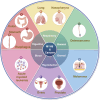Exploring the nexus between MYH9 and tumors: novel insights and new therapeutic opportunities
- PMID: 39149512
- PMCID: PMC11325155
- DOI: 10.3389/fcell.2024.1421763
Exploring the nexus between MYH9 and tumors: novel insights and new therapeutic opportunities
Abstract
The myosin heavy chain 9 (MYH9) gene, located on human chromosome 22, encodes non-muscle myosin heavy chain IIA (NM IIA). This protein is essential to various cellular events, such as generating intracellular chemomechanical force and facilitating the movement of the actin cytoskeleton. Mutations associated with thrombocytopenia in autosomal dominant diseases first highlighted the significance of the MYH9 gene. In recent years, numerous studies have demonstrated the pivotal roles of MYH9 in various cancers. However, its effects on cancer are intricate and not fully comprehended. Furthermore, the elevated expression of MYH9 in certain malignancies suggests its potential as a target for tumor therapy. Nonetheless, there is a paucity of literature summarizing MYH9's role in tumors and the therapeutic strategies centered on it, necessitating a systematic analysis. This paper comprehensively reviews and analyzes the pertinent literature in this domain, elucidating the fundamental structural characteristics, biological functions, and the nexus between MYH9 and tumors. The mechanisms through which MYH9 contributes to tumor development and its multifaceted roles in the tumorigenic process are also explored. Additionally, we discuss the relationship between MYH9-related diseases (MYH9-RD) and tumors and also summarize tumor therapeutic approaches targeting MYH9. The potential clinical applications of studying the MYH9 gene include improving early diagnosis, clinical staging, and prognosis of tumors. This paper is anticipated to provide novel insights for tumor therapy.
Keywords: MYH9; NM IIA; clinical translations; therapeutic target; tumor.
Copyright © 2024 Gou, Zhang, Cao, Li, Li, Zhao, Wang, Wang and Zhou.
Conflict of interest statement
The authors declare that the research was conducted in the absence of any commercial or financial relationships that could be construed as a potential conflict of interest.
Figures
Similar articles
-
Nonmuscle Myosin Heavy Chain IIA Mutation Predicts Severity and Progression of Sensorineural Hearing Loss in Patients With MYH9-Related Disease.Ear Hear. 2016 Jan-Feb;37(1):112-20. doi: 10.1097/AUD.0000000000000198. Ear Hear. 2016. PMID: 26226608
-
MYH9: A key protein involved in tumor progression and virus-related diseases.Biomed Pharmacother. 2024 Feb;171:116118. doi: 10.1016/j.biopha.2023.116118. Epub 2024 Jan 5. Biomed Pharmacother. 2024. PMID: 38181716 Review.
-
MYH9-Related Thrombocytopenia: Four Novel Variants Affecting the Tail Domain of the Non-Muscle Myosin Heavy Chain IIA Associated with a Mild Clinical Evolution of the Disorder.Hamostaseologie. 2019 Feb;39(1):87-94. doi: 10.1055/s-0038-1645840. Epub 2018 Jul 11. Hamostaseologie. 2019. PMID: 29996171
-
Unveiling the enigmatic role of MYH9 in tumor biology: a comprehensive review.Cell Commun Signal. 2024 Aug 27;22(1):417. doi: 10.1186/s12964-024-01781-w. Cell Commun Signal. 2024. PMID: 39192336 Free PMC article. Review.
-
The abnormal proplatelet formation in MYH9-related macrothrombocytopenia results from an increased actomyosin contractility and is rescued by myosin IIA inhibition.J Thromb Haemost. 2013 Dec;11(12):2163-75. doi: 10.1111/jth.12436. J Thromb Haemost. 2013. PMID: 24165359
Cited by
-
Role of myosin heavy chain 9 in gastrointestinal tumorigenesis: A comprehensive review.World J Gastrointest Oncol. 2025 Jun 15;17(6):106617. doi: 10.4251/wjgo.v17.i6.106617. World J Gastrointest Oncol. 2025. PMID: 40547174 Free PMC article. Review.
-
Human congenital cataract mutation in MYH9 alters F-actin organization and cell functions.Int J Ophthalmol. 2025 Jun 18;18(6):969-977. doi: 10.18240/ijo.2025.06.01. eCollection 2025. Int J Ophthalmol. 2025. PMID: 40534807 Free PMC article.
-
The p-MYH9/USP22/HIF-1α axis promotes lenvatinib resistance and cancer stemness in hepatocellular carcinoma.Signal Transduct Target Ther. 2024 Sep 19;9(1):249. doi: 10.1038/s41392-024-01963-5. Signal Transduct Target Ther. 2024. PMID: 39300073 Free PMC article.
References
-
- (2014). MYH9 regulates p53 stability and is a tumor suppressor in SCC. Cancer Discov. 4 (3), OF22. 10.1158/2159-8290.CD-RW2014-023 - DOI - PubMed
Publication types
LinkOut - more resources
Full Text Sources
Miscellaneous



